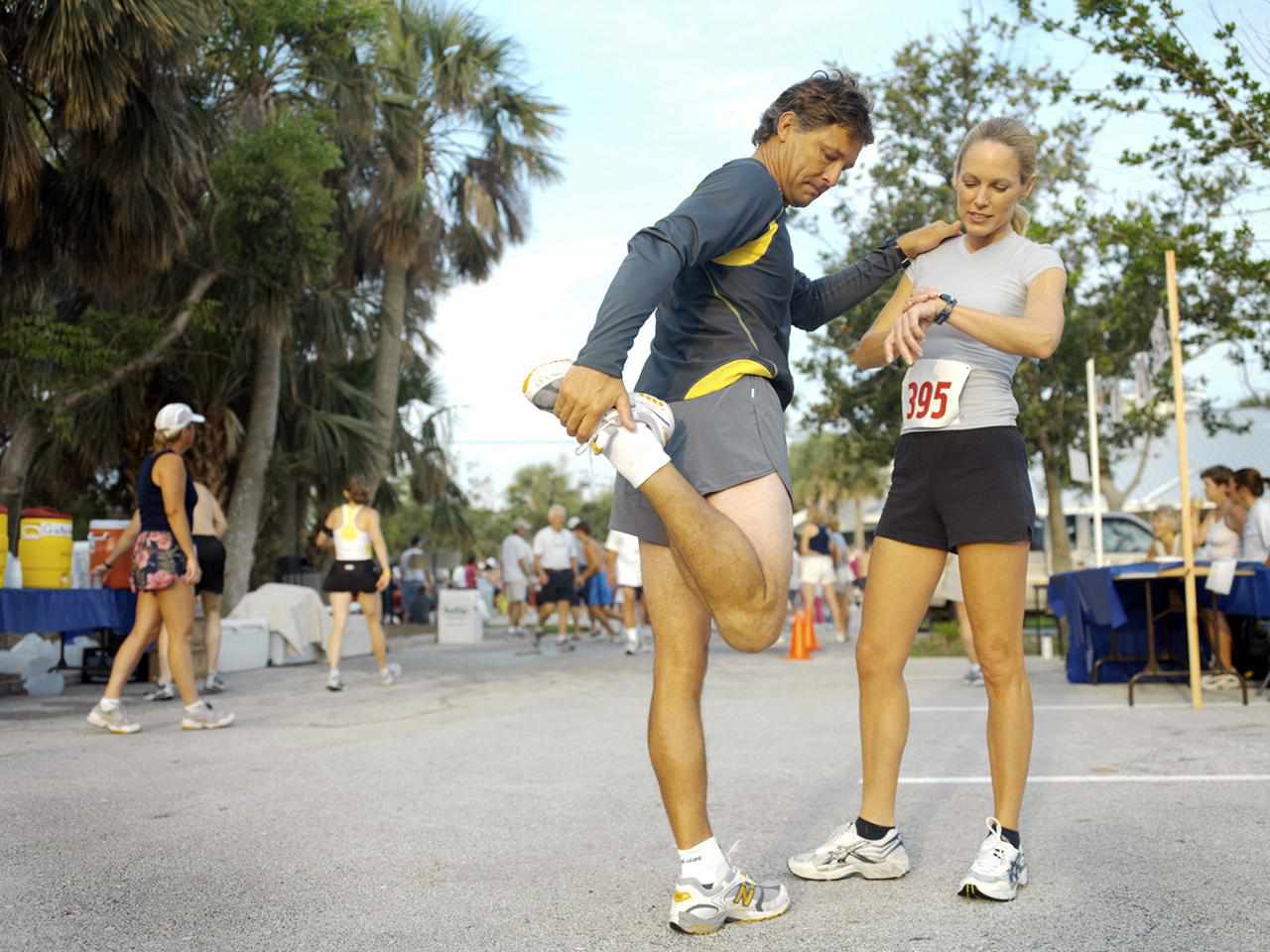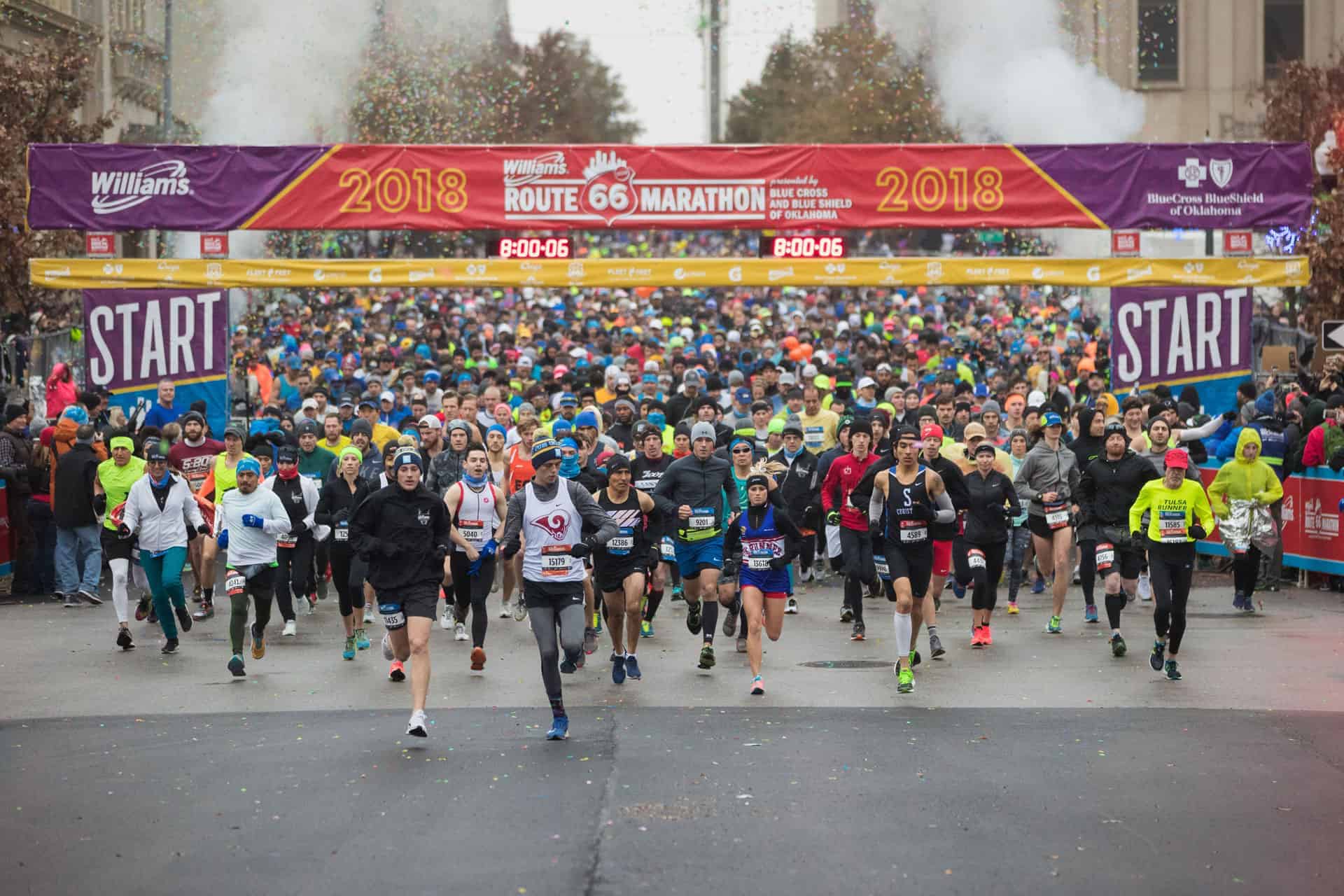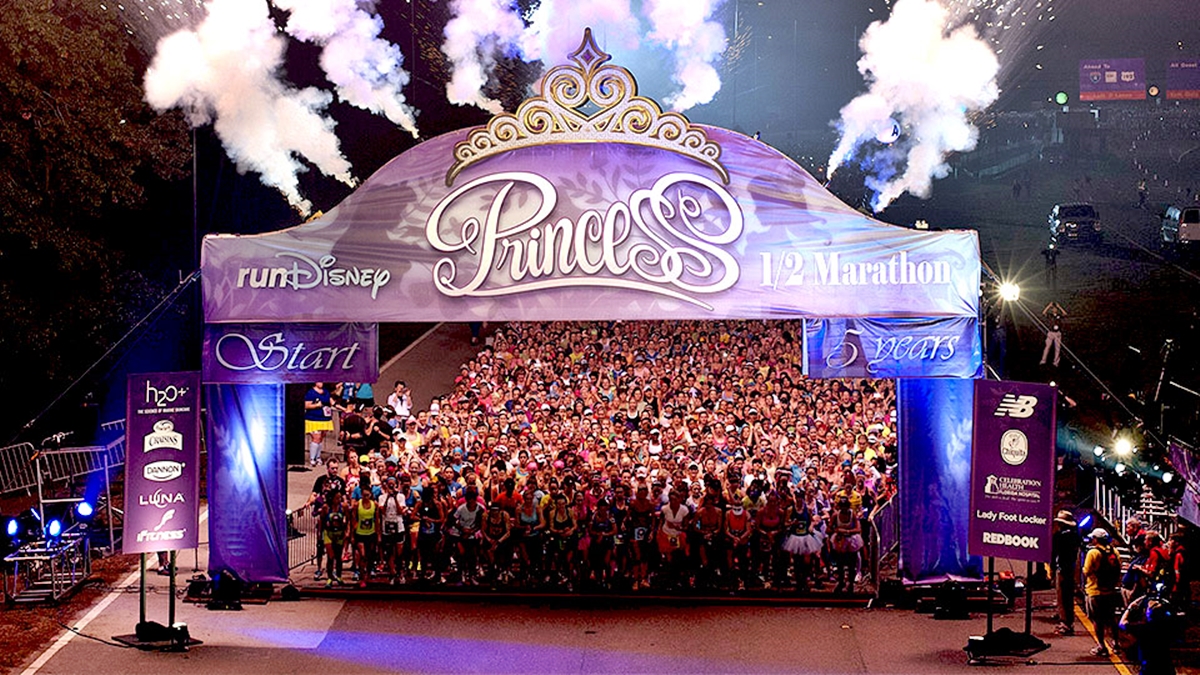Home>Misc>Featured>How To Train For A Half Marathon In 6 Months


Featured
How To Train For A Half Marathon In 6 Months
Modified: August 21, 2023
Discover how to train for a half marathon in just 6 months with our featured guide. Reach your running goals and conquer the distance.
Introduction
Training for a half marathon is an exciting and challenging endeavor that requires dedication, discipline, and proper planning. Whether you are a seasoned runner looking to conquer a new distance or a beginner seeking a fitness goal, completing a half marathon is an achievement that can positively impact your physical and mental well-being.
Running 13.1 miles may seem daunting at first, but with the right mindset and training program, you can cross that finish line with confidence and pride. This article will guide you through the process of training for a half marathon in six months, providing you with key tips and strategies to optimize your preparation.
Before diving into the specifics of training, it is essential to evaluate your current fitness level and set realistic goals. Assessing your baseline fitness will help you determine an appropriate starting point and ensure that you gradually progress without risking injury or burnout.
Beyond simply completing the race, think about what you hope to achieve from this experience. Is it to improve your speed, increase your endurance, or challenge yourself mentally? Understanding your motivation will keep you focused and motivated throughout the training process.
Remember, training for a half marathon requires consistency and patience. Rome wasn’t built in a day, and neither will your endurance. By following a structured training plan, incorporating proper nutrition and recovery strategies, and staying mentally strong, you can conquer this challenging distance.
In the following sections, we will dive into the details of each step, from creating a training plan to strengthening your muscles and improving flexibility. With determination and perseverance, you will be well on your way to crossing the finish line of your first (or next) half marathon.
Setting Your Goal
Setting a clear and achievable goal is the first step in your half marathon training journey. Your goal will serve as a guiding light, motivating you to stay on track and push yourself during the training process.
When setting your goal, consider both the distance and the time you aim to complete the half marathon. It’s important to strike a balance between setting a challenging target and ensuring it is attainable with the time and resources you have available.
One common goal for first-time half marathon runners is to simply finish the race. This goal is perfectly valid, as completing a half marathon is already a significant accomplishment. It’s important to acknowledge that the training journey itself is filled with personal growth and milestones, regardless of the final race time.
If you’re a more experienced runner or looking to push yourself further, you may want to set a time goal. Research the average finishing times for your age group and gender, and use that as a benchmark to set a realistic time goal. Keep in mind that your personal fitness level and prior running experience will influence your performance.
Setting a specific goal will help you structure your training program. It will give you an idea of the pace and intensity you need to maintain during your workouts. Additionally, having a tangible target in mind can be a great source of motivation, pushing you to work harder during each training session.
Remember that it’s okay to adjust your goal as you progress through your training. Be open to reevaluating and adjusting your target if necessary, especially if you encounter setbacks or unexpected circumstances along the way.
Finally, write down your goal and keep it somewhere visible. This will serve as a constant reminder and motivator, especially during those challenging training runs when you may need an extra push. Visualize yourself crossing the finish line, achieving your goal, and relish in the sense of accomplishment that awaits you.
With a clear and attainable goal in mind, you are ready to move on to the next step – creating a training plan that will lead you to success.
Creating a Training Plan
A well-structured training plan is essential for preparing your body and mind for the demands of a half marathon. It provides a roadmap to gradually increase your mileage, improve your endurance, and minimize the risk of injury.
When creating your training plan, consider the following key factors:
- Mileage: Determine the number of days per week you can commit to running and establish a baseline mileage. If you are a beginner, start with a comfortable distance that challenges you but does not leave you completely exhausted. As you progress, gradually increase your weekly mileage by around 10% to avoid overtraining.
- Long Runs: Incorporate a weekly long run into your training schedule. Start with a distance that is slightly longer than your current comfortable run and gradually increase it each week. Aim to complete your longest run a few weeks before the race—around 9-10 miles for a half marathon. This will build your confidence and ensure that you are prepared for the full distance.
- Rest and Recovery: Don’t overlook the importance of rest days. Scheduled rest days allow your body to recover and repair itself, preventing overuse injuries. Plan for at least one or two days each week where you engage in low-impact activities or rest completely. Listen to your body and adjust your training schedule accordingly.
- Cross-Training: Incorporating cross-training activities such as cycling, swimming, or strength training into your plan can help improve overall fitness and reduce the risk of injury. Aim to cross-train at least once or twice a week, focusing on exercises that target different muscle groups and support your running performance.
- Interval and Tempo Runs: To build speed and improve cardiovascular fitness, include interval and tempo runs in your training plan. Interval runs involve alternating between high-intensity bursts of running and slower recovery periods, while tempo runs consist of running at a comfortably hard pace for an extended period. These workouts will help you develop endurance and increase your race pace.
- Tapering: During the final two to three weeks leading up to the race, decrease your mileage to allow your body to rest and recover. This process is known as tapering and ensures that you arrive at the starting line feeling refreshed and fully prepared to perform your best on race day.
Remember that every individual is unique, so feel free to tailor your training plan to suit your specific needs and preferences. Be flexible and willing to make adjustments along the way to accommodate unforeseen circumstances or to address any challenges that may arise.
By creating a well-rounded and progressive training plan, you set yourself up for success, increase your chances of injury-free running, and build confidence as race day approaches.
Building Your Endurance
When it comes to successfully completing a half marathon, building your endurance is crucial. It allows your body to adapt to the demands of a longer distance, helping you maintain a steady pace throughout the race.
Here are some strategies to help you improve your endurance:
- Gradually Increase Mileage: Over the course of your training plan, gradually increase your weekly mileage. The goal is to build up your distance capabilities while avoiding overexertion and potential injuries. Focus on adding a few extra miles each week, allowing your body the time to adjust and adapt. Consistent, gradual mileage increases will steadily improve your endurance.
- Long Runs: Incorporate regular long runs into your routine. These runs should be at a slower pace than your shorter training runs, allowing you to develop greater endurance. Start with a comfortable distance and add a mile or two each week. Your longest run should be a few weeks before the race to simulate the race day distance.
- Tempo Runs: Tempo runs, also known as threshold runs, involve running at a comfortably hard pace for an extended period. These runs improve your lactate threshold, which is the point at which lactic acid builds up in your muscles. Incorporating tempo runs into your training helps you maintain a faster pace for longer periods, increasing your endurance and race performance.
- Hill Training: Including hill training in your training plan has numerous benefits, including building endurance. Running uphill forces your muscles to work harder, increasing your overall stamina. Hill repeats, where you run up and down a hill multiple times, are especially effective at building both strength and endurance.
- Interval Training: Interval training involves alternating between high-intensity bursts of running and recovery periods. These sessions improve your cardiovascular fitness and increase your anaerobic capacity, allowing you to run at a faster pace for longer durations. Incorporate interval workouts once or twice a week to enhance your endurance and speed.
- Consistency: Consistency is key when building endurance. Stick to your training schedule, making sure to complete your weekly mileage and long runs as planned. Even if you have to cut back on the intensity occasionally, maintaining consistency will optimize your endurance gains.
Remember to listen to your body and avoid pushing yourself too hard. Overtraining can lead to fatigue, burnout, and injury, ultimately hindering your progress. Be patient and trust the process, gradually building your endurance over time.
As you consistently implement these strategies into your training, you will notice improvements in your stamina and ability to sustain longer distances. Building your endurance is an important foundation for a successful half marathon, and it will serve you well on race day.
Incorporating Speed Workouts
Speed workouts are a vital component of half marathon training that help improve your running economy and increase your overall speed. These workouts not only enhance your performance but also boost your confidence when maintaining a faster pace during the race.
Here are some key tips for incorporating speed workouts into your training:
- Interval Training: Interval training involves alternating between periods of high-intensity efforts and recovery periods. Incorporate intervals into your training plan by selecting a specific distance, such as 400 meters or 800 meters, and running them at a faster pace than your usual training runs. Allow yourself enough recovery time between intervals to fully recover before the next repetition.
- Fartlek Runs: Fartlek, which means “speed play” in Swedish, is a form of unstructured speed training. During a fartlek run, you spontaneously pick up the pace for a certain duration or distance, and then return to your regular training pace. This type of workout adds variety and unpredictability to your training, mimicking real-life race situations.
- Hill Repeats: Hill repeats are an effective way to build strength and speed. Find a moderate to steep hill and run up it at a challenging pace, then recover by jogging or walking back down. Repeat the process several times. Running uphill forces your muscles to work harder, making you stronger and faster in the process.
- Progressive Runs: Progressive runs involve gradually increasing your pace throughout the run. Start at an easy pace and gradually pick up speed as you go, finishing strong with a faster pace for the last few miles or minutes. Progressive runs simulate race-day efforts and help you improve your ability to maintain a faster pace over longer distances.
- Track or Treadmill Workouts: Utilize a track or treadmill for structured speed workouts. These controlled environments allow you to accurately measure your speed and distance while maintaining a consistent pace. You can perform various interval and tempo workouts on a track or a treadmill to target different aspects of your speed development.
- Recovery and Adaptation: Speed workouts can be physically demanding, so it’s important to allow sufficient recovery time for your body to adapt to the intensity. Avoid scheduling back-to-back hard workouts and ensure you have enough rest days and easy runs in your training plan to facilitate recovery and reduce the risk of overtraining.
Remember to warm up properly before each speed workout by incorporating dynamic stretches and a gradual buildup of intensity. Cooling down and stretching afterward can also aid in recovery and reduce muscle soreness.
As you progressively incorporate speed workouts into your training plan, you’ll notice improvements in your race pace and overall speed. However, it’s important to strike a balance between speed work and endurance training, as both are crucial for half marathon success.
By strategically implementing speed workouts into your training regimen, you’ll enhance your running efficiency, boost your race performance, and unlock your full potential on race day.
Strengthening Your Muscles
Building strength in your muscles is essential for half marathon training. Strengthening your muscles not only improves your overall running performance but also helps prevent injuries and promotes better running form. Incorporating strength training exercises into your routine will enhance your running economy and increase your endurance. Here are some key tips for strengthening your muscles:
- Include Strength Training: Dedicate two to three days per week to strength training exercises. Focus on targeting the major muscle groups involved in running, such as your legs, glutes, core, and upper body. Incorporate exercises such as squats, lunges, deadlifts, planks, push-ups, and rows to build strength and stability throughout your body.
- Use Bodyweight Exercises: Bodyweight exercises are an effective way to build strength without the need for equipment. You can do exercises like squats, lunges, mountain climbers, planks, and push-ups, all of which engage multiple muscle groups simultaneously. These exercises improve your functional strength and enhance your overall running performance.
- Resistance Training: Integrate resistance training into your routine using weights, resistance bands, or machines. Exercises such as leg presses, kettlebell swings, calf raises, and seated rows can help increase muscle strength and power. Gradually increase the weight or resistance as you progress to continuously challenge your muscles.
- Focus on Leg Strength: Running is primarily a lower-body activity, so it’s important to prioritize leg strength exercises. Exercises like squats, lunges, step-ups, and hamstring curls target the quadriceps, hamstrings, glutes, and calves. Strong legs provide power and stability, making you more efficient and less prone to injuries.
- Core Stability: A strong core is vital for maintaining good posture, stability, and balance while running. Incorporate exercises such as planks, Russian twists, bicycle crunches, and Superman poses to strengthen your abdominal muscles and improve overall core stability. Strong core muscles support your spine and pelvis, enhancing your running form.
- Don’t Forget Upper Body Strength: Though running primarily engages the lower body, having a strong upper body is still beneficial. A strong upper body helps with arm swing coordination and posture, especially during long distances. Include exercises like push-ups, pull-ups, shoulder presses, and rows to develop upper body strength.
- Functional Strength: Incorporate functional strength exercises that mimic the movements and demands of running. Single-leg exercises like single-leg squats or lunges and stability exercises on a balance board or Bosu ball help improve stability and prevent muscle imbalances. These exercises simulate running-specific movements and improve overall running performance.
- Proper Form and Technique: When performing strength exercises, prioritize proper form and technique. Use controlled movements, maintain good posture, and ensure the appropriate range of motion. If needed, seek guidance from a fitness professional to ensure you are performing exercises correctly to maximize their benefits.
Remember to listen to your body and start with weights that challenge you without compromising your form. Gradually increase the weight or resistance over time to continue challenging your muscles. Consistency is key, so make strength training a regular part of your training routine to see long-term benefits.
By incorporating strength training into your training plan, you’ll develop stronger muscles, improve overall running performance, and reduce the risk of injuries, allowing you to become a stronger and more efficient half marathon runner.
Improving Flexibility and Mobility
Improving flexibility and mobility is often overlooked in half marathon training, but it plays a crucial role in optimizing your running performance and preventing injuries. Incorporating flexibility and mobility exercises into your routine will enhance your range of motion, running efficiency, and overall body functioning. Here are some key tips for improving flexibility and mobility:
- Dynamic Warm-up: Prioritize a dynamic warm-up routine before each running session. Dynamic stretches and movements prepare your muscles for activity and increase blood flow to the working muscles. Incorporate exercises like leg swings, walking lunges, high knees, and arm circles to loosen up your joints and increase mobility.
- Static Stretching: After your run or workout, perform static stretches to improve flexibility and prevent muscle tightness. Focus on the major muscle groups used in running, such as your quadriceps, hamstrings, calves, hip flexors, and glutes. Hold each stretch for 15-30 seconds, making sure to breathe deeply and relax into the stretch.
- Yoga and Pilates: Consider adding yoga or Pilates sessions to your training schedule. These practices improve flexibility, balance, and core strength. Various poses and exercises in yoga and Pilates target the muscles that are commonly tight in runners, helping to alleviate muscle imbalances and improve overall mobility.
- Foam Rolling and Self-Myofascial Release (SMR): Use a foam roller or a massage ball for self-myofascial release. Roll out the muscles in your legs, glutes, and back to release tension and knots in the muscles and improve tissue quality. Foam rolling aids in reducing muscle tightness, increasing flexibility, and promoting faster recovery.
- Stretching Routine: Design a regular stretching routine that focuses on the muscles prone to tightness and imbalances in runners. Incorporate stretches for the calves, hip flexors, hamstrings, quadriceps, and glutes. Consistency is key, so allocate time for stretching after each workout or set aside dedicated stretching sessions.
- Active Recovery: On rest days or recovery days, engage in low-impact activities that promote flexibility and mobility. Activities such as swimming, cycling, and light jogging allow gentle movement of your muscles and joints, enhancing blood circulation and promoting recovery without putting excessive stress on your body.
- Incorporate Mobility Exercises: Include mobility exercises that focus on improving joint range of motion, such as hip circles, leg swings, ankle circles, and shoulder rotations. These exercises help loosen up tight muscles and improve joint mobility, resulting in better running form and efficiency.
- Listen to Your Body: Pay attention to any areas of tightness or discomfort during your runs. If you feel any pain or restrictions in your range of motion, address them with targeted stretches and mobility exercises. Be mindful of your body’s signals and adjust your training as needed to prevent overuse injuries.
Improving flexibility and mobility is an ongoing process that takes time and consistency. Gradually incorporate these exercises into your training routine and listen to your body’s feedback. By enhancing your flexibility and mobility, you’ll experience improved running performance, reduced muscle imbalances, and a decreased risk of injuries, ultimately helping you achieve your half marathon goals.
Maintaining a Balanced Diet
Achieving optimal performance in your half marathon training requires not only physical exercise but also proper fueling. Maintaining a balanced diet that supports your training and recovery is critical for sustained energy levels, muscle repair, and overall well-being. Here are some key tips for maintaining a balanced diet:
- Consume Adequate Calories: Ensure that you are consuming enough calories to support your training and energy needs. Calculate your daily caloric requirements, considering your activity level and training intensity. Aim to consume a balanced mix of macronutrients, including carbohydrates, proteins, and healthy fats.
- Carbohydrates: Carbohydrates are an essential energy source for runners. Prioritize complex carbohydrates from whole grains, fruits, vegetables, and legumes. These provide sustained energy, essential vitamins, and minerals. Include a good variety of carbs in your meals to meet your energy requirements.
- Protein: Protein is crucial for muscle repair and recovery. Include lean sources of protein such as chicken, turkey, fish, tofu, beans, and Greek yogurt in your meals. Aim for a moderate amount of protein with each meal to support muscle growth and repair.
- Fruits and Vegetables: Incorporate a wide range of fruits and vegetables into your diet to ensure a good intake of vitamins, minerals, and antioxidants. These will support overall health, help fight inflammation, and provide essential nutrients for your body’s needs.
- Hydration: Hydration is key for optimal performance. Aim to drink enough water throughout the day to stay properly hydrated. Monitor your urine color to ensure it is pale yellow, indicating good hydration. During longer runs, carry water or sports drinks to replenish fluids lost through sweat.
- Pre- and Post-Workout Nutrition: Before running, eat a balanced meal or snack that includes carbohydrates and a small amount of protein. This will provide the necessary energy to perform your best. After your run, consume a combination of carbs and protein to aid in muscle recovery and replenish glycogen stores.
- Healthy Fats: Incorporate healthy fats from sources like nuts, seeds, avocados, and oils. These fats provide energy and support nutrient absorption. Include a moderate amount of healthy fats in your diet to maintain overall health and satiety.
- Vitamins and Minerals: Ensure you are getting a variety of vitamins and minerals through a diverse diet. Consider incorporating a wide range of colorful fruits and vegetables, as they are rich in antioxidants and essential nutrients that support a healthy immune system and aid in recovery.
- Meal Planning: Plan and prepare your meals in advance to ensure you have nutritious options readily available. This will help you avoid relying on processed or unhealthy food choices when hunger strikes. Prioritize whole foods and home-cooked meals to have greater control over the quality and nutrient content of your meals.
- Listen to Your Body: Pay attention to how different foods make you feel during training. Experiment with different pre-run and recovery meal options to find what works best for you. Everybody is different, so observe how your body responds to certain foods to optimize your fueling strategies.
Remember that it’s about overall balance and nourishing your body with nutritious foods. Be mindful of portion sizes, eat mindfully, and listen to your body’s hunger and fullness cues.
By maintaining a balanced diet that provides the fuel your body needs, you’ll support your training, enhance recovery, and improve your overall performance in your half marathon.
Hydration and Recovery
Proper hydration and recovery are essential aspects of half marathon training that are often overlooked. Hydration is crucial for maintaining performance and preventing dehydration, while recovery allows your body to repair, adapt, and prepare for your next training session. Here are some key tips for hydrating and recovering effectively:
- Stay Hydrated: Drink water regularly throughout the day to maintain proper hydration. Hydration needs vary depending on factors such as humidity, temperature, and duration of your runs. Aim to drink at least 8-10 cups (64-80 ounces) of water daily and adjust your intake based on your body’s needs.
- Pre-Run Hydration: Drink water or a sports drink about 1-2 hours before your run to ensure hydration levels are optimal. This will help prevent dehydration during your workout. Avoid drinking excessive fluids immediately before running to prevent discomfort.
- During-Run Hydration: During longer runs or intense workouts, carry water or a sports drink with you to replenish fluids lost through sweat. Consider using a hydration belt or handheld water bottle for convenience. Aim to consume about 4-6 ounces of fluid every 20 minutes during your run.
- Post-Run Hydration: Rehydrate after your run to replace fluids lost during exercise. Drink water or a sports drink within 30 minutes of finishing your run. Consuming fluids promptly helps restore hydration levels and aids in the recovery process.
- Electrolyte Balance: Electrolytes, such as sodium, potassium, and magnesium, are essential for proper hydration and muscle function. When you sweat during exercise, you lose electrolytes along with fluid. Consider consuming electrolyte-rich beverages or adding electrolyte tablets to your water to maintain a proper balance.
- Recovery Nutrition: After your run, consume a balanced meal or snack that includes carbohydrates and protein. This replenishes glycogen stores and aids in muscle repair. Enjoy a meal or snack that combines high-quality carbohydrates, lean protein, and healthy fats to optimize recovery and enhance muscle rebuilding.
- Rest and Sleep: Adequate rest and quality sleep are key components of recovery. Your body repairs and regenerates muscle tissue during rest periods, so ensure you are getting enough sleep each night. Aim for 7-9 hours of quality sleep to optimize recovery and performance.
- Active Recovery: Engage in active recovery activities to promote blood flow and relieve muscle soreness. Gentle activities such as walking, stretching, or light yoga can assist in the recovery process by aiding in muscle relaxation and reducing tightness.
- Sports Massage: Consider incorporating sports massages into your training routine to help with recovery. Massages improve blood circulation, relieve muscle tension, and promote relaxation. Schedule regular massages to support muscle recovery and prevent injury.
- Listen to Your Body: Pay attention to your body’s signals and adjust your training or recovery plan accordingly. If you feel excessively fatigued, experience persistent muscle soreness, or notice a decrease in performance, it may be a sign that you need additional rest or recovery time.
Hydration and recovery are ongoing processes that require attention and constant monitoring. By staying hydrated and prioritizing proper recovery, you’ll optimize your training, minimize the risk of injuries, and perform at your best during your half marathon.
Avoiding Common Training Mistakes
Training for a half marathon requires careful planning and execution to achieve your goals successfully. While it’s important to focus on building endurance and improving your running performance, it’s equally crucial to avoid common training mistakes that can hinder your progress and increase the risk of injury. Here are some key tips to help you avoid these common training mistakes:
- Skipping Rest Days: Rest days are just as important as training days. Your body needs time to recover and repair. Skipping rest days can lead to overtraining, fatigue, and increased risk of injuries. Incorporate rest days into your training plan to allow your muscles and joints to recover and adapt to the demands of training.
- Ignoring Warning Signs: Pay attention to your body’s warning signs. If you experience persistent pain, discomfort, or extreme fatigue, it’s important to listen to your body and address these issues promptly. Pushing through pain or ignoring warning signs can lead to further injury and setbacks in your training.
- Not Following a Structured Training Plan: Having a structured training plan helps ensure consistent progress and minimizes the risk of overtraining. Winging your training without a plan can lead to inconsistent workouts, inadequate progression, and a lack of focus on key areas. Develop or seek out a structured training plan that suits your needs and goals to ensure a systematic approach to your training.
- Excessive Mileage Increases: Gradual mileage increases are essential for building endurance and preventing injuries. Avoid the temptation to increase your mileage too quickly, as it can overload your body and lead to overuse injuries. Aim for a weekly mileage increase of around 10% to give your body time to adapt and recover.
- Improper Form and Technique: Running with incorrect form and technique can place unnecessary stress on your body, leading to inefficient movement and potential injuries. Focus on maintaining good posture, stride length, and foot strike. Consider working with a running coach or seeking expert advice to ensure proper form and technique.
- Neglecting Cross-Training and Strength Workouts: Incorporating cross-training and strength workouts into your training plan is essential for building overall fitness and minimizing imbalances. Neglecting these workouts can limit your progress and increase the risk of overuse injuries. Include activities such as swimming, cycling, strength training, and flexibility exercises to improve your overall fitness and support your running performance.
- Improper Nutrition and Hydration: Fueling your body with proper nutrition and hydration is critical for optimal performance and recovery. Avoiding or neglecting adequate nutrition and hydration can lead to decreased energy levels, poor performance, and compromised recovery. Prioritize a balanced diet, including carbohydrates, proteins, healthy fats, vitamins, and minerals, and stay properly hydrated throughout your training.
- Pushing Through Pain or Illness: While it’s important to challenge yourself during training, it’s equally essential to pay attention to your body’s signals and take appropriate action. Pushing through pain or illness can exacerbate injuries or lead to more serious health issues. If you’re not feeling well or have an injury, listen to your body and make necessary adjustments to your training plan.
- Comparing Yourself to Others: Avoid the temptation to constantly compare yourself to other runners. Each individual has their own unique strengths, weaknesses, and training journeys. Focus on your own progress, celebrate your achievements, and embrace the process. Remember that your journey is personal, and progress at your own pace.
- Neglecting Mental Preparation: Mental preparation is just as important as physical training for a half marathon. Neglecting mental strength and focus can impact your performance on race day. Incorporate strategies such as visualization, positive affirmations, and mindfulness practices to strengthen your mental resilience and stay motivated throughout your training.
Avoiding these common training mistakes will help you stay on track, minimize the risk of injury, and maximize your performance during your half marathon. Remember to listen to your body, seek guidance when needed, and stay consistent in your training efforts.
Mental Preparation and Motivation
Training for a half marathon not only requires physical endurance but also mental strength and motivation. Your mindset plays a critical role in your ability to push through challenges, stay focused, and ultimately achieve your goals. Here’s how you can enhance your mental preparation and motivation:
- Set Clear Goals: Define your goals for the half marathon and set clear, achievable targets. Having specific goals gives you something to strive for and helps you stay motivated throughout your training. Whether it’s completing the race, improving your time, or reaching a personal best, clarify your goals and remind yourself of them regularly.
- Visualize Success: Visualization is a powerful mental technique that can enhance your performance. Visualize yourself crossing the finish line, feeling strong and confident. Imagine the sensations, sights, and sounds of race day. By visualizing success, you train your mind to believe in your abilities and overcome obstacles that may arise during training and the race itself.
- Positive Self-Talk: Pay attention to the dialogue in your mind and replace negative thoughts with positive affirmations. Encourage yourself during challenging workouts or when doubts arise. Replace self-criticism with self-belief and motivation. Repeat positive affirmations such as “I am strong, I am capable, and I can do this.”
- Break it Down: Breaking your training into manageable milestones can make the journey seem less overwhelming. Focus on one workout at a time, one week at a time, and one long run at a time. By focusing on smaller segments, you can maintain motivation and build confidence as you progressively achieve each milestone.
- Find a Training Buddy: Having a training partner or joining a running group can provide accountability, support, and motivation. Running with others who share similar goals can boost camaraderie and make training more enjoyable. Sharing experiences, challenges, and triumphs can help keep you motivated and committed to your training.
- Celebrate Milestones: Acknowledge and celebrate your progress along the way. Whether it’s completing a certain mileage, achieving a personal best time, or conquering a challenging workout, celebrate these milestones. Reward yourself with small gestures like a rest day, a massage, or a favorite treat. Recognizing and celebrating your achievements will reinforce your commitment and boost your motivation.
- Find Inspiration: Seek inspiration from other runners, race stories, and motivational quotes. Read books, watch documentaries, or listen to podcasts about running to stay motivated and gain new perspectives. Surround yourself with positive influences that remind you of the incredible collective journey of runners worldwide.
- Cross-Train: Incorporate cross-training activities that you enjoy into your training plan. Engaging in activities such as yoga, cycling, swimming, or hiking can break the monotony of running and keep your motivation levels high. Cross-training also helps prevent burnout and provides mental stimulation.
- Practice Mindfulness: Being present and mindful during your training runs can enhance your mental focus. Pay attention to your breath, the rhythm of your footsteps, and the scenery around you. This helps you stay in the present moment and enjoy the journey rather than constantly focusing on the end goal.
- Stay Flexible: Remember that there may be unexpected setbacks or challenges during your training. Stay flexible and adjust your mindset and plans accordingly. Adaptability is key to maintaining motivation and staying positive in the face of any obstacles that may arise.
By prioritizing mental preparation and motivation, you can cultivate a resilient mindset that will carry you through the highs and lows of your half marathon training. Believe in yourself, stay positive, and embrace the mental aspect of your journey to achieve your goals.
Final Thoughts
Training for a half marathon is a challenging yet rewarding journey that requires dedication, perseverance, and proper planning. Throughout this article, we have explored the various aspects of preparing for a half marathon in six months. From setting clear goals and creating a structured training plan to improving endurance, incorporating speed workouts, and strengthening muscles, each step plays a crucial role in your success.
We’ve discussed the importance of flexibility and mobility, maintaining a balanced diet, and prioritizing hydration and recovery. By avoiding common training mistakes and nurturing a positive mindset, you can maximize your training efforts and achieve your desired results. The mental aspect of training is just as important as the physical, so remember to stay motivated, set milestones, and celebrate your progress along the way.
As you embark on your half marathon journey, it’s essential to listen to your body, make adjustments when necessary, and be kind to yourself. Remember that everyone’s training journey is unique, and progress may vary. Focus on your own growth and improvement, and trust in the process.
Throughout your training, there will be moments of doubt, fatigue, and challenges. But by consistently putting in the effort, staying committed to your goals, and maintaining a positive mindset, you will have the strength and determination to overcome any obstacles that come your way.
Remember, a half marathon is not just about crossing the finish line but also about the journey itself. Embrace the ups and downs, celebrate your achievements, and enjoy the process of self-discovery and personal growth that comes with training for and completing a half marathon.
Now, lace up your running shoes, visualize your success, and embark on this incredible journey. With the right mindset, proper training, and unwavering perseverance, you will conquer that half marathon and experience an immense sense of accomplishment that will stay with you for a lifetime.









